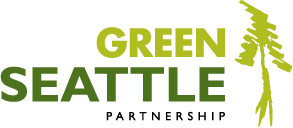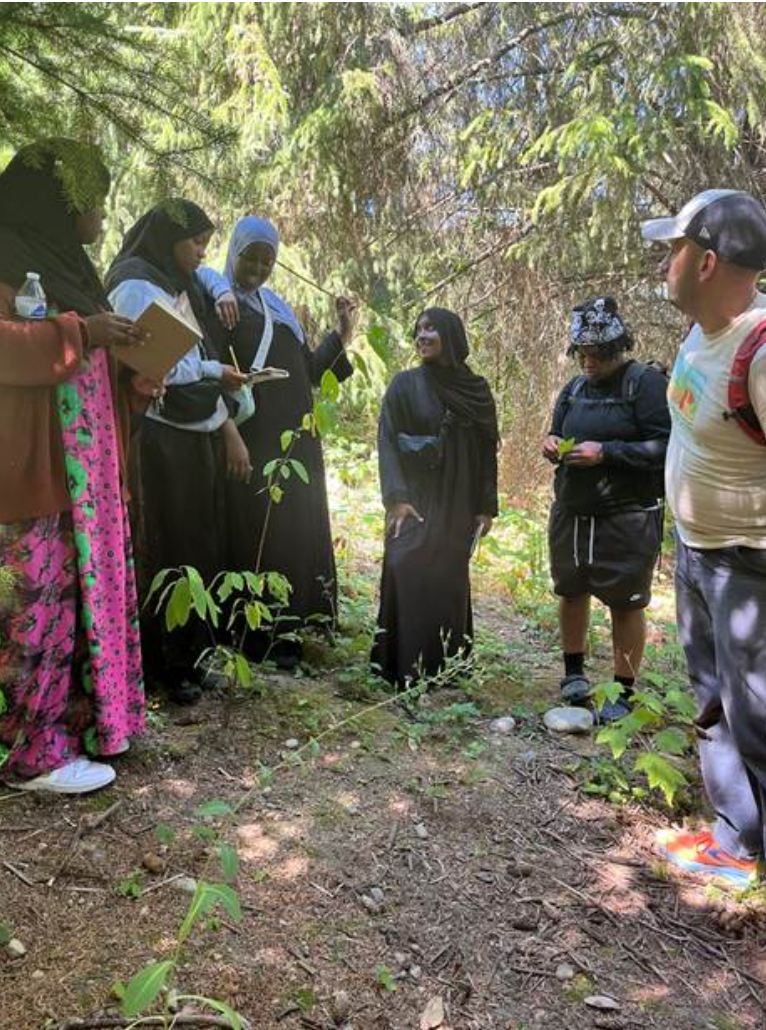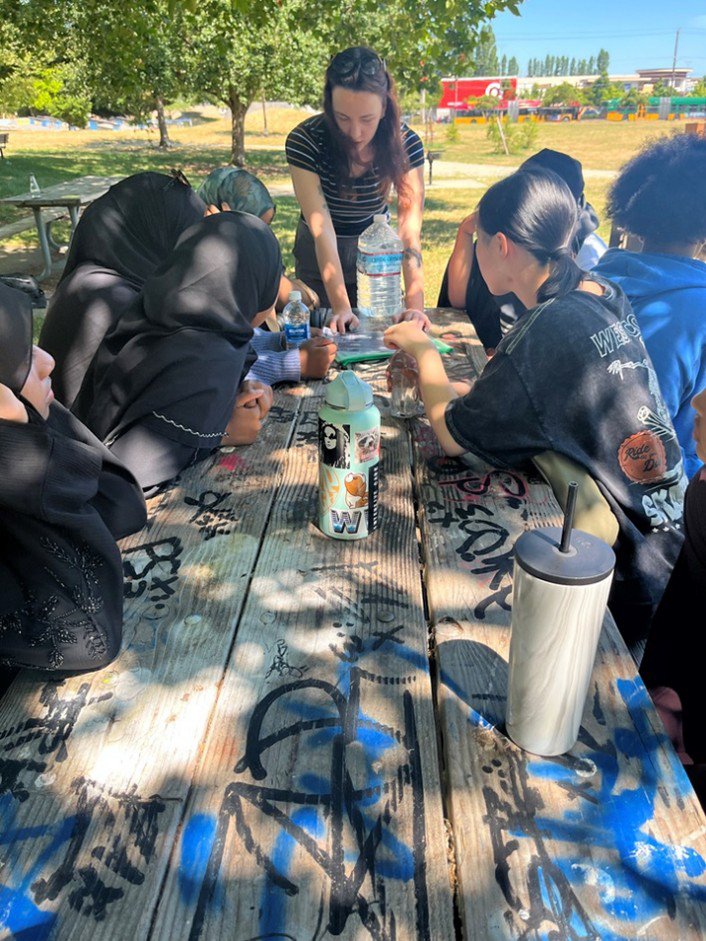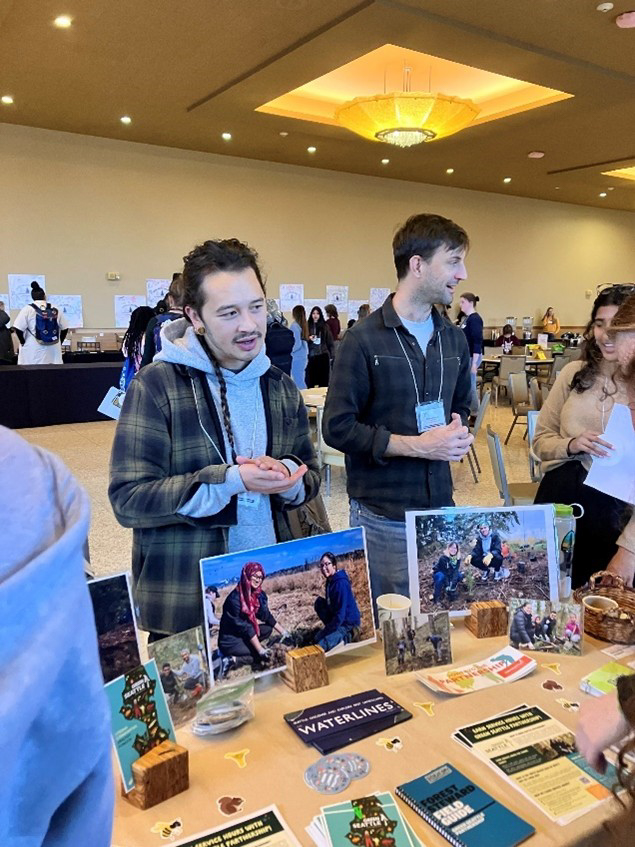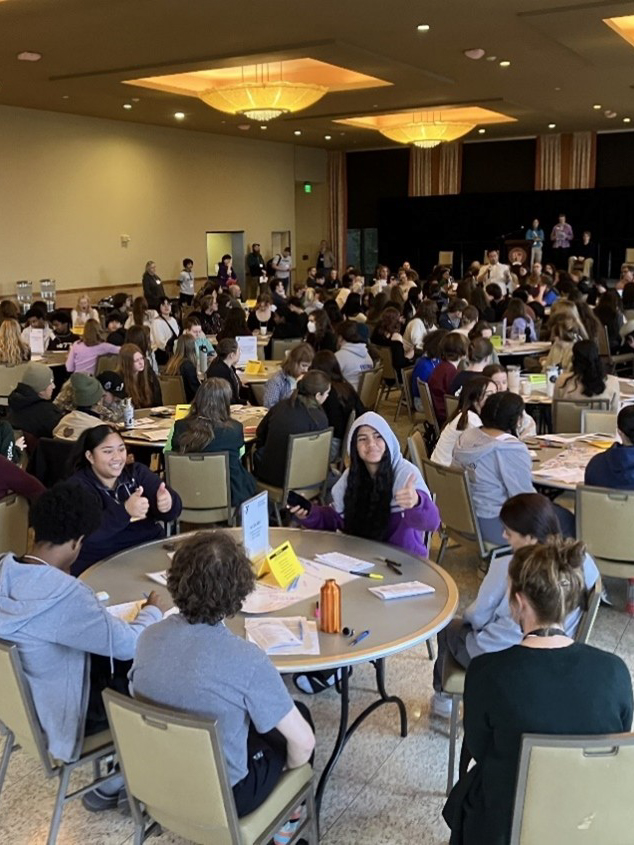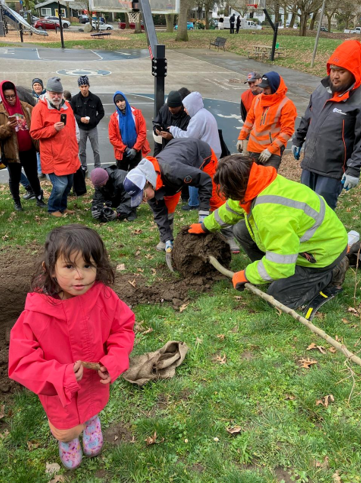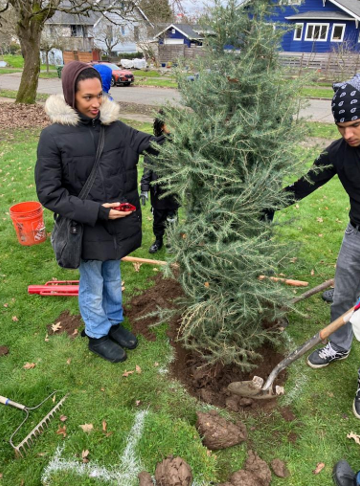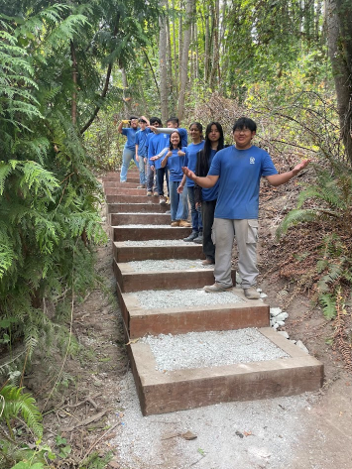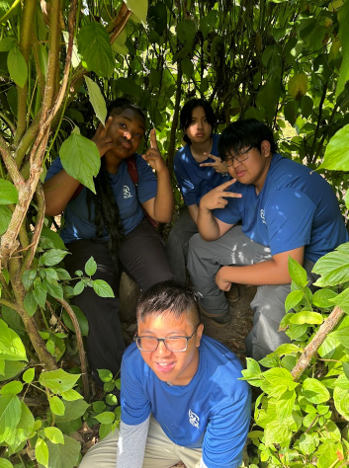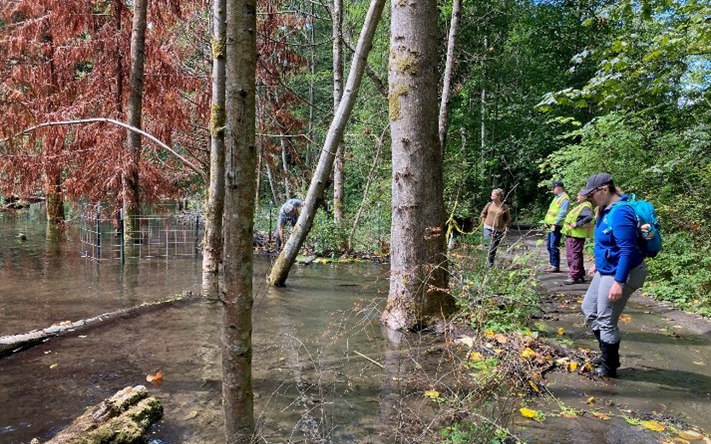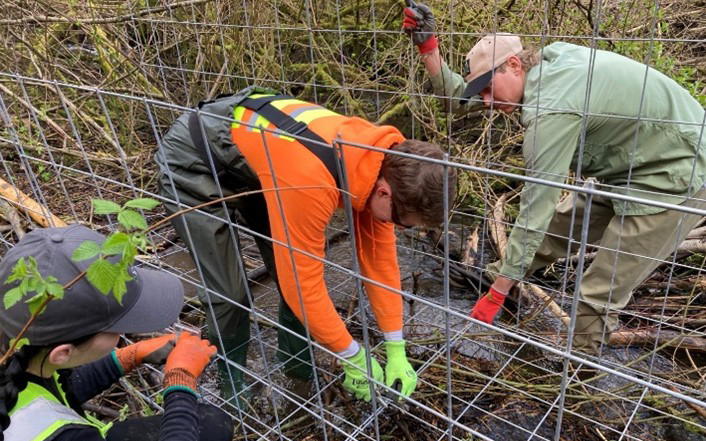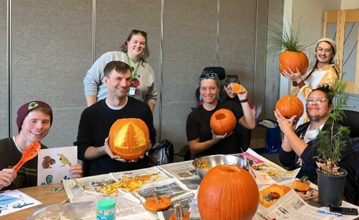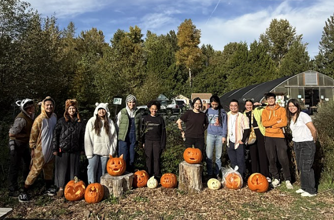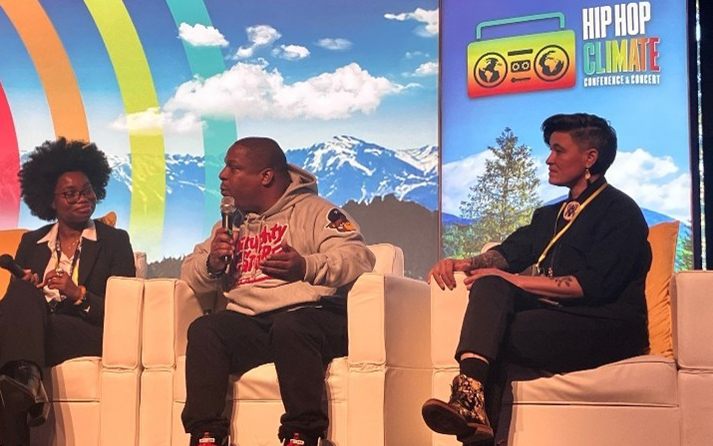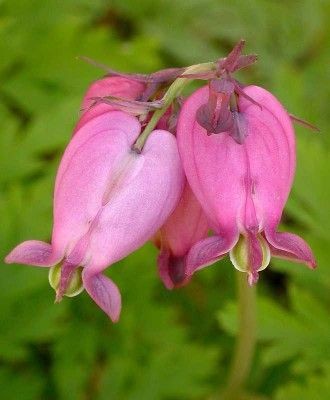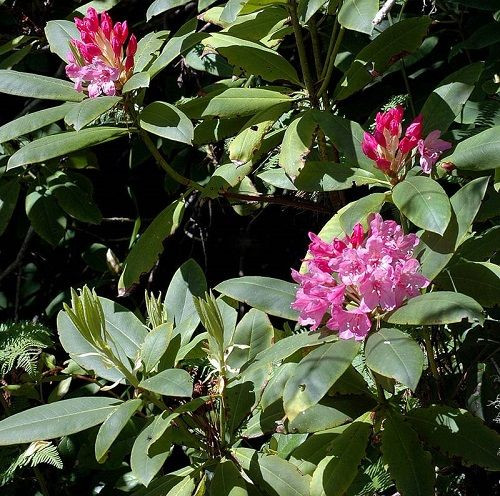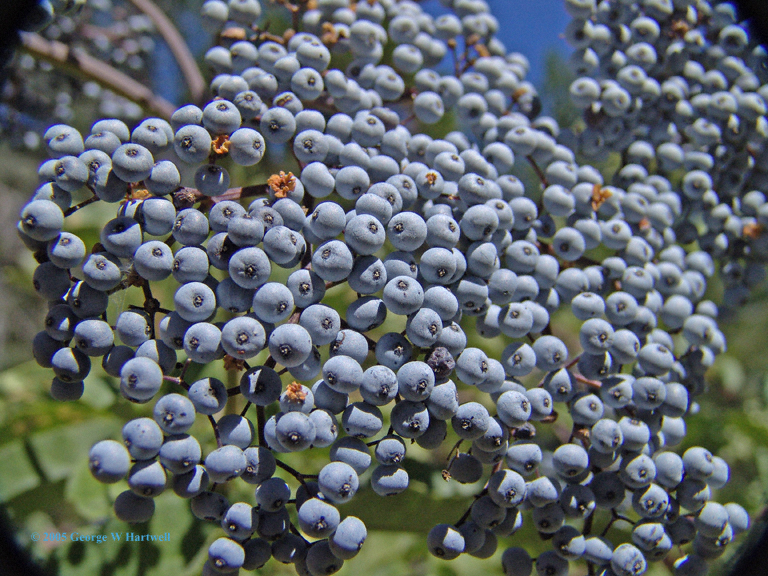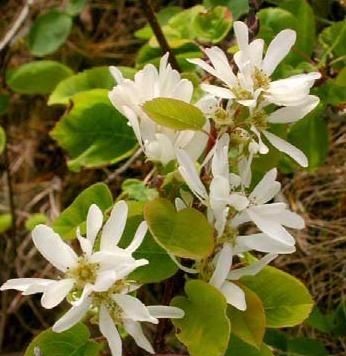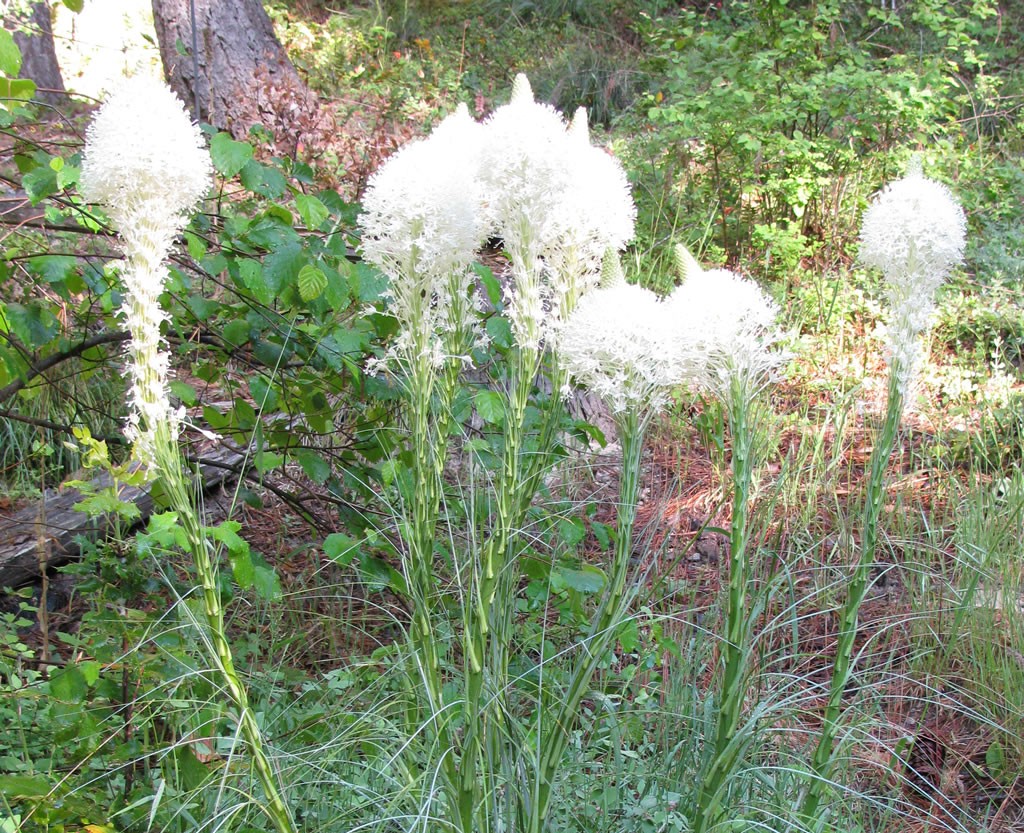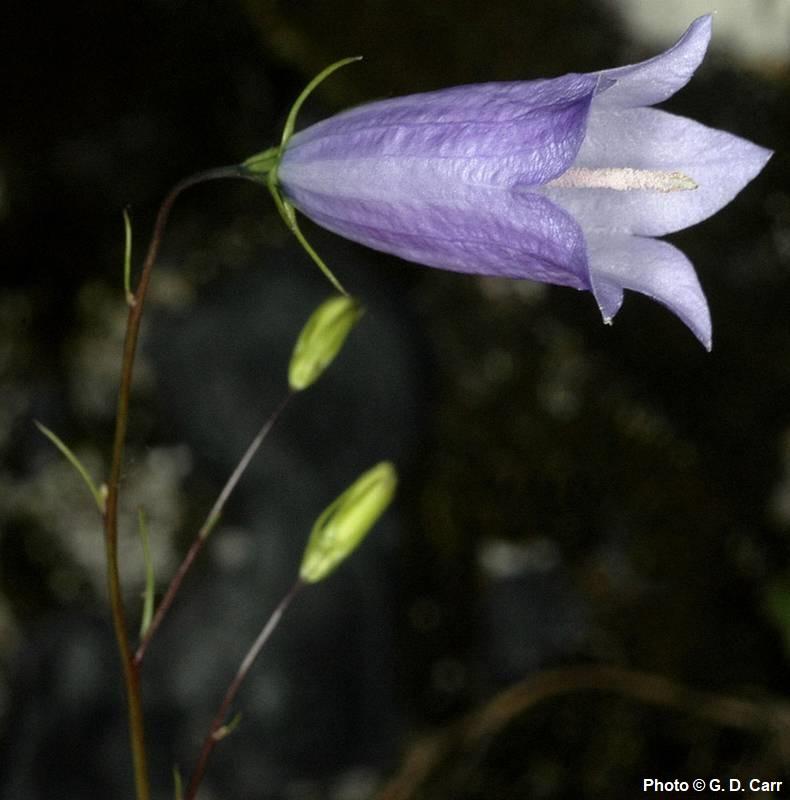Growth, Partnerships, Stewardship, and More!
Another incredible and dynamic year has wrapped for Green Seattle Partnership! In our 19th year of programming, GSP continues to showcase our powerful and unique role within the city ecosystem, restoring forested parklands and expanding land care opportunities for Seattle communities.
A big thank you to the 15 public partner organizations, 6 professional crews, 148 active forest stewards, the Natural Area Crew, Seattle Parks and Recreation and the thousands of everyday volunteers that make up the Green Seattle Partnership.
This year we improved on a number of our restoration metrics, including enrollment of 35 new acres into restoration, 9,000 trees cleared of vines, installation of 74,000 native plants including 7,642 trees at 114 parks. 64% of stewardship occurred in priority equity neighborhoods bringing 2032 total areas into restoration.
Within our community, we hosted 1,502 land care events, providing 47,000 volunteers service hours equivalent to $1.9 million dollars. We hosted 78 schools during events, led 6 community knowledge-sharing workshops – coordinating programming with 210 paid participants that expanded job skills and career readiness, and supported 148 active Forest Stewards as they each led restoration and community engagement in their neighborhood park. WOW!
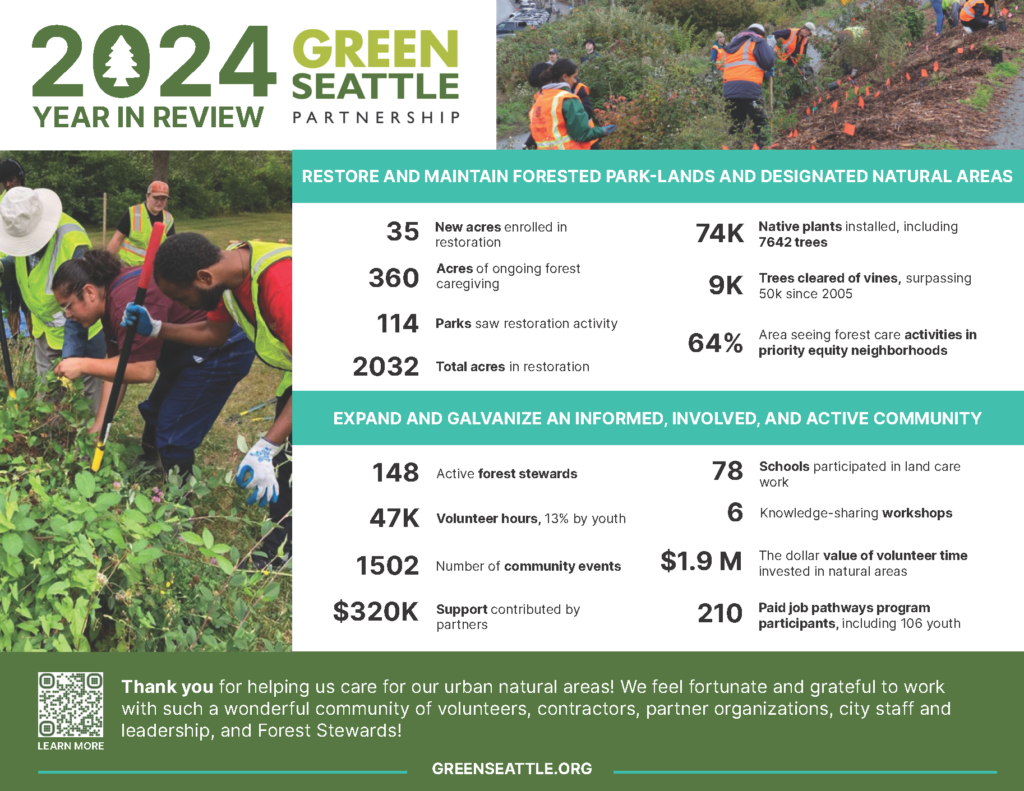
Keep scrolling for a look at our year in photos!

2024 was another successful year for Green Seattle Day and Seattle Forest Week! This year 319 volunteers hosted by eight different GSP partner organizations installed 2400 native plants at 12 different natural areas. This year’s theme was Nurturing Forests and Futures: Youth Engagement in Seattle’s Urban Forest.” Above Green Seattle Day community volunteer stewardship party hosted by Partner in Employment’s Youth Environmental Restoration program staff at Kubota Garden Natural Area.
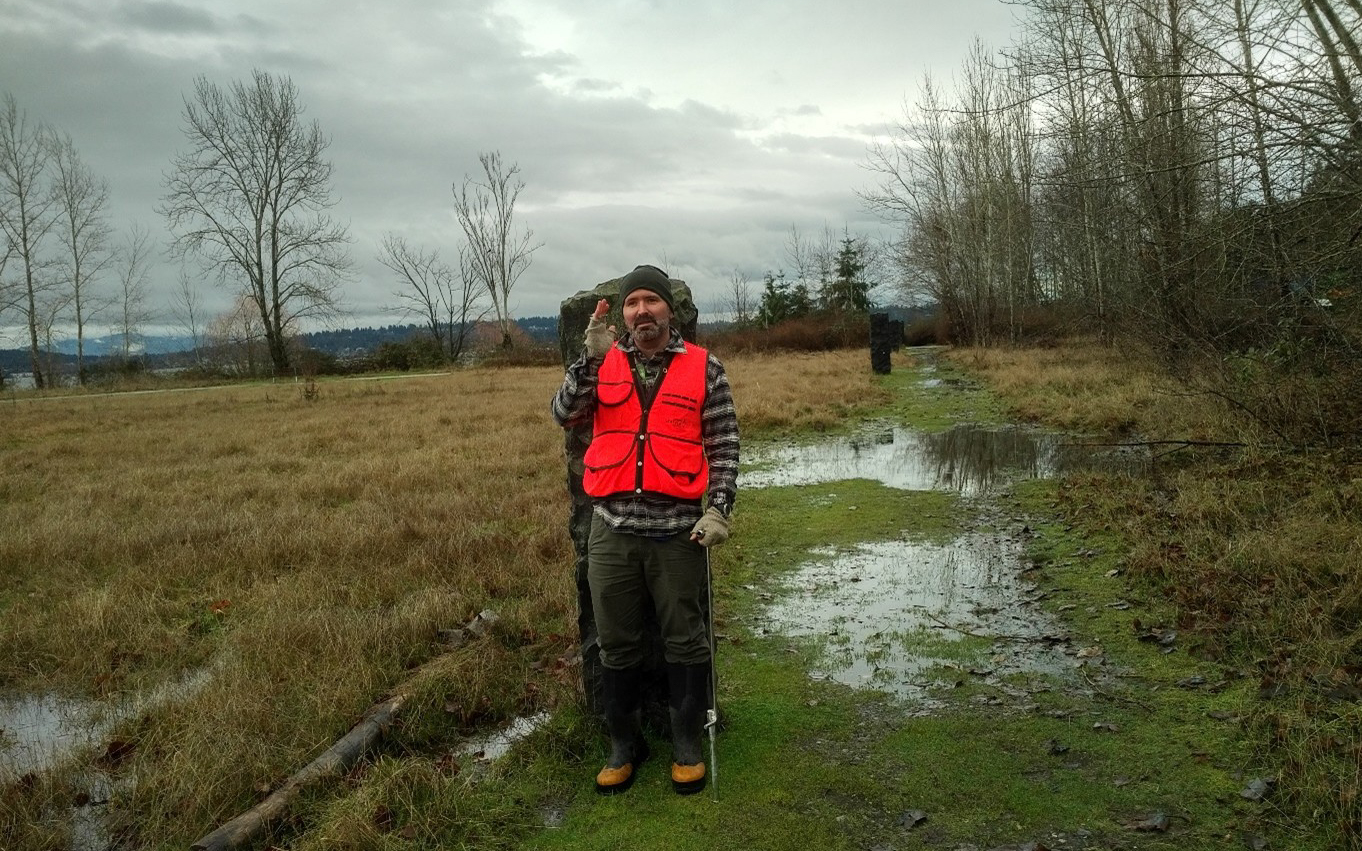
A ‘departure from the norm’ is a both a classic metaphor to describe a significant ecological change and an apt description for departure of long-time Plant Ecologist Michael Yadrick from GSP. Michael served the GSP program for 14 years and his impact on the program is immeasurable. Michael hasn’t gone far! He accepted a new position as a Restoration Ecologist with City of Tacoma.
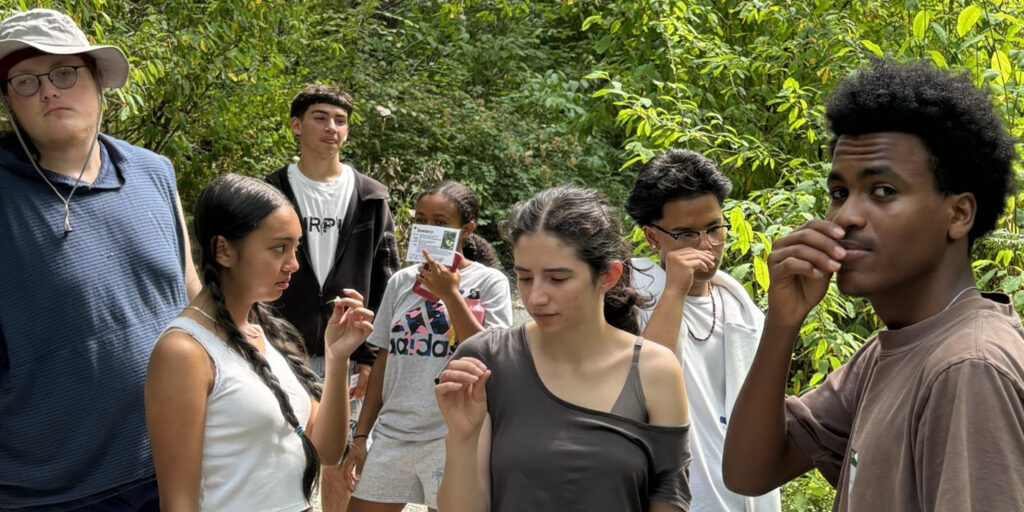
Tilth Alliance Rainer Beach Youth Stewards use their sense of smell to identify and familiarize themselves with Grand Fir while on a native plant ID walk with Seattle Parks and Recreation Plant Ecologist Jacob de Guzman. Participants practiced mindfulness, breathing exercises and place-based observation as part of their summer professional development program at Rainer Beach Urban Farm and Wetlands.
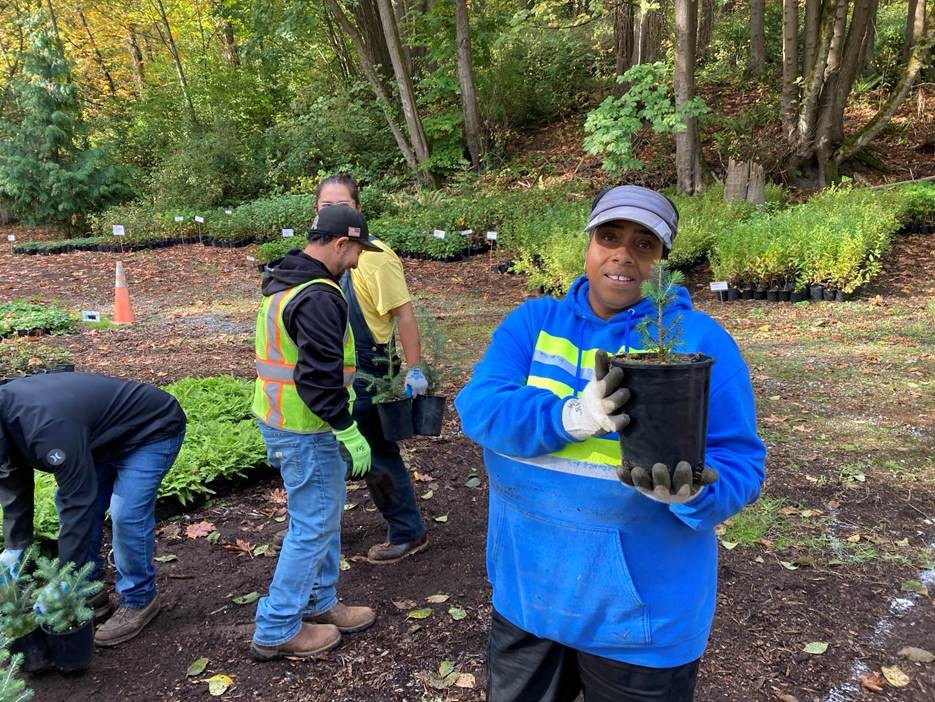
Seattle Parks and Recreation’s Natural Areas Crew member Melonae Hill with a young Sitka spruce tree, one of over 34,778 plants that the NAC received, organized and delivered to forest stewards and community-led partner organizations for planting in natural areas around town. The process of preparing the site, assembling a temporary nursery and delivering thousands of plants each year takes on average two and a half months to complete and is the main way that GSP forest stewards and affiliated community organizations obtain plants for their restoration projects. This year, NAC incorporated new best practices which eliminated the chance for spread of pathogens between plants coming from different nurseries, resulting in significantly less plant mortality while storing plants in the nursery.
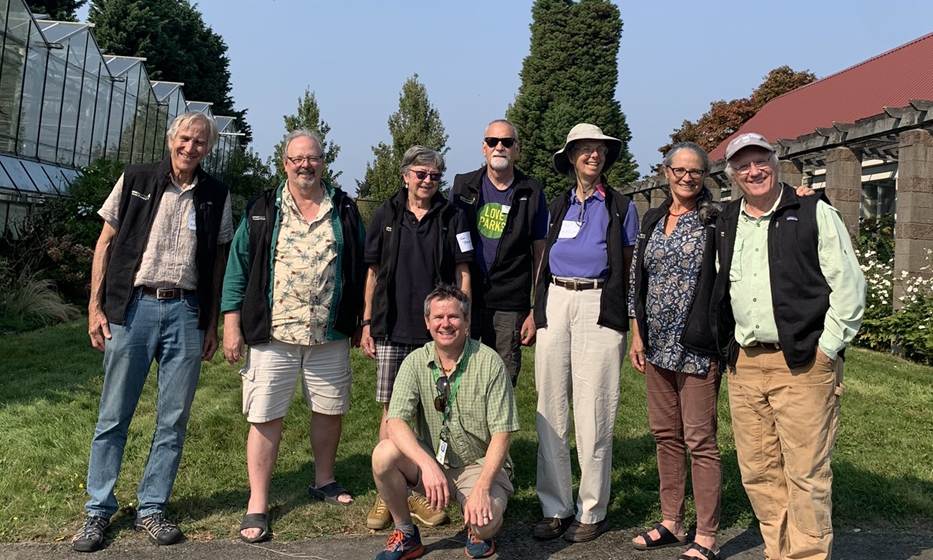
As we do each summer, Green Seattle Partnership celebrated the amazing accomplishments of our Forest Stewards, including recognizing those who reached an important milestone with the program–10 years of volunteer service! From left to right: Don Syverson, Rick Paulsen, Susan Brimhall, Peter Kalmes, Antje Mueller, Elly Hale, Brad Rogers Not pictured: Cristi Lien, Jim Denison, Joel DeJong, Lisa Ray, Matt Chadsey, Paul Fairbairn, Paul Shannon, Susan Zeman

Community Connections was a new three-part series piloted in 2024 by Seattle Parks and Recreation’s GSP team to support wider access to the program by highlighting stewardship opportunities through Public Partners and Forest Stewards. Session 1 (virtual): Meeting the Challenge of Restoring Urban Forests. Session 2: Inclusive Community Engagement with Tilth Alliance’s Cameryn Tam and Delridge Neighborhood Development Association’s Caroline Borsenik & Ben Antonious (photo above).

Session 3: Restoration Best Practices and Hands-on Training with Seattle Parks and Recreation’s Natural Area Crew Senior Gardener Matthew Hilliard at Maple Wood Playfield Natural Area.
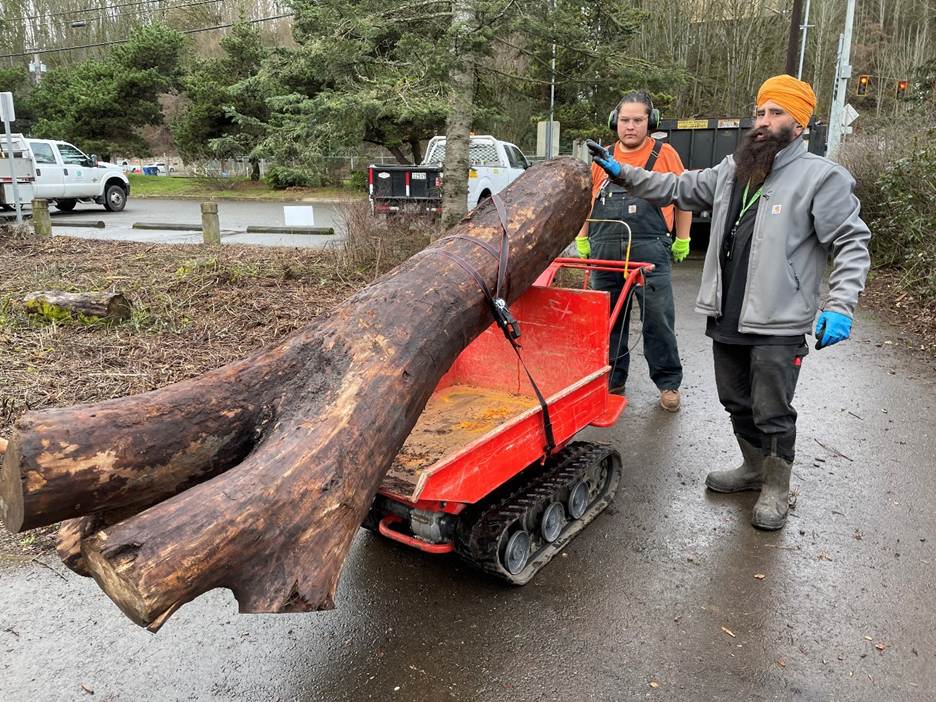
Seattle Parks and Recreation Natural Area Crew members Claire Yazza and Daljit Singh moved logs in to Herring’s House Park (Tualtwx) to protect plantings and enhance the site’s ecology. Herring’s House Park is one of seven sites where NAC performed regular establishment and enhancement activities. Located right across from the Duwamish Longhouse, it is a culturally important site to the Duwamish people, and one of few green spaces along the Duwamish River, providing tidal marsh habitat vital to salmon. Along with doing professional crew work at the park, NAC hosted a volunteer work party here and supported the work of forest stewards who partner with the Duwamish Alive Coalition to put on annual community events to celebrate and restore life to the river.
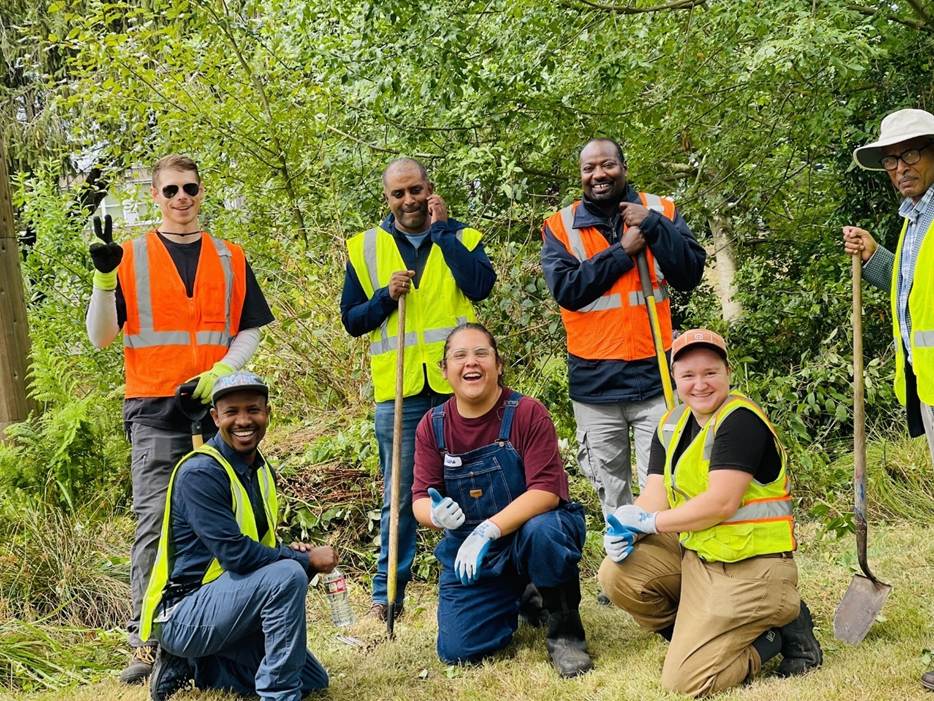
Seattle Parks and Recreation’s Natural Area Crew supported skill development with Serve Ethiopians Washington (SEW) volunteers and staff, offering hands on support with non-desirable and persistent weed management in salmon-bearing Mapes Creek at Be’er Sheva Park. SEW sought to improve their knowledge of ecological restoration to take the lead on continued restoration of the creek. NAC reviewed and demonstrated best practices with SEW during two workshops, leading the group through weed removal along the streambanks, and teaching them about aspects of stream restoration that require extra mindfulness compared to other ecosystems.
DNDA Nature Consortium’s Environmental Justice Summer Youth Program participants immersed and learned in West Seattle’s urban forests, participating in forest restoration and learning more about their neighborhoods through an environmental education lens.
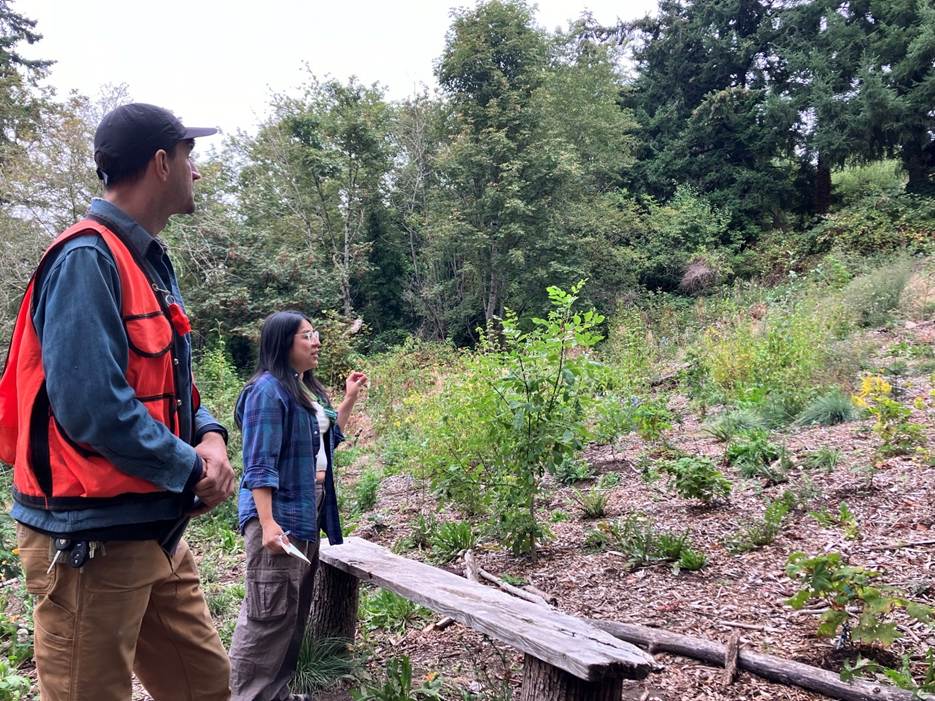
Seattle Parks and Recreation Plant Ecologist Michael Helms and SPR Naturalist Nicolasa Hernandez discussed stewardship and support for a site for Cleveland High School students in the Maple School Ravine as part of the TrEE program, a collaboration for Trees, Equity and Education.
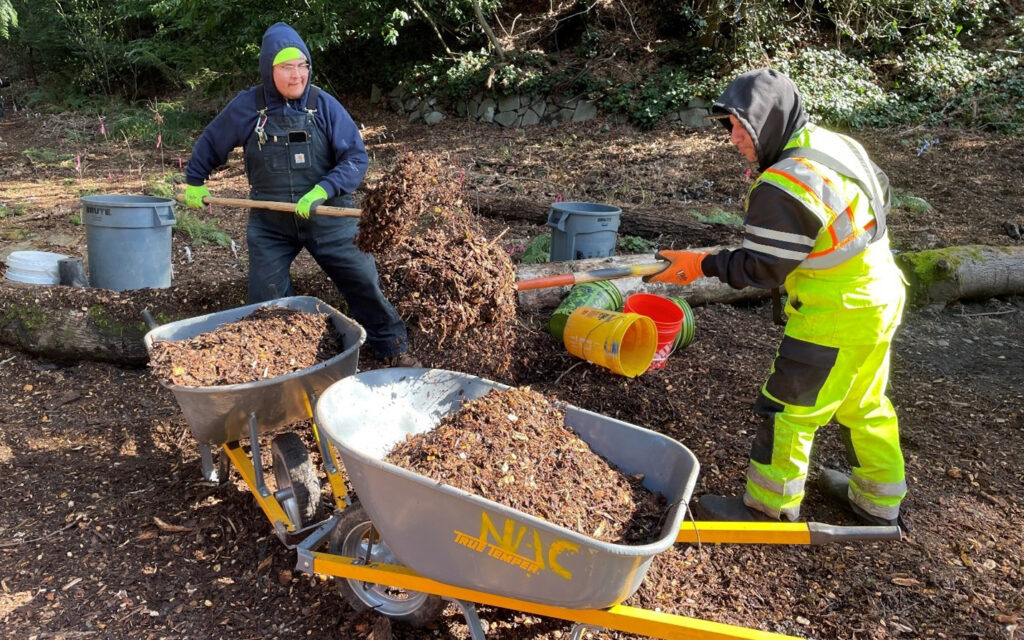
Seattle Parks and Recreation Natural Areas Crew members Herbert Arias and Claire Yazza load wheelbarrows of mulch to spread around new plantings at Pelly Place Natural Area in West Seattle. Pelly Place is a natural area tucked away in the neighborhood just north of Lincoln Park. The NAC’s work here has greatly enhanced the ecology of the natural area which has a small stream flowing through it, fed by a wetland upslope, both of which trap stormwater pollution flowing from nearby roads before the water reaches Puget Sound.
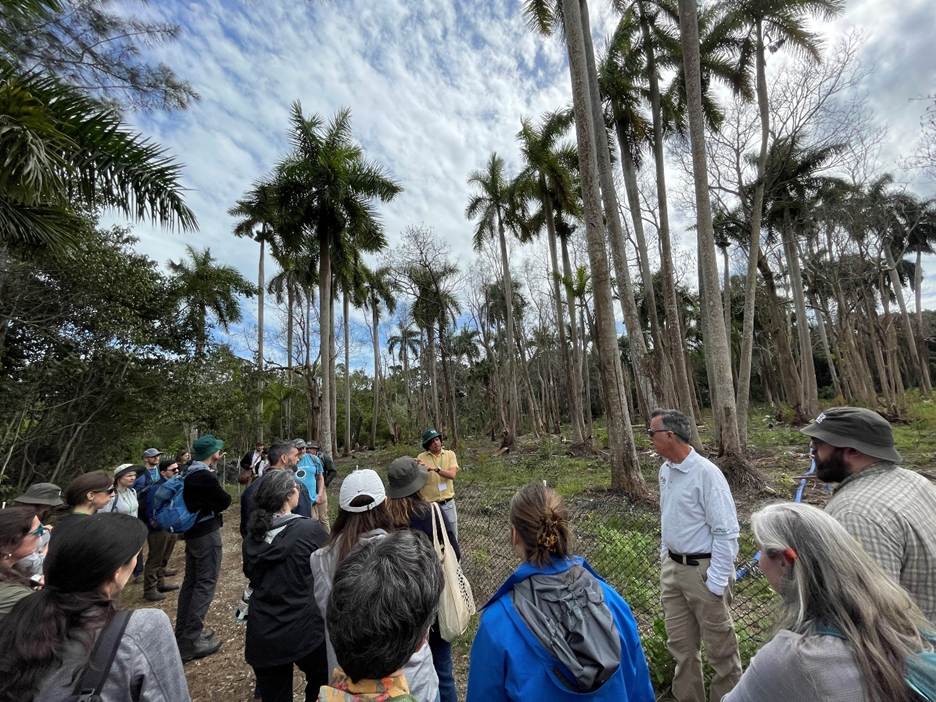
A delegation from Seattle , including staff from Seattle Parks and Recreation, Futures Rising, and the Green-Duwamish Urban Waters Federal Partnership, met with colleagues from 14 other US cities in Miami as part of the national Forest in Cities Network. The group shared best practices in species conservation, climate adaptation, and community participation, building on past efforts to build a professional community of practice focused specifically on the care of urban natural areas.
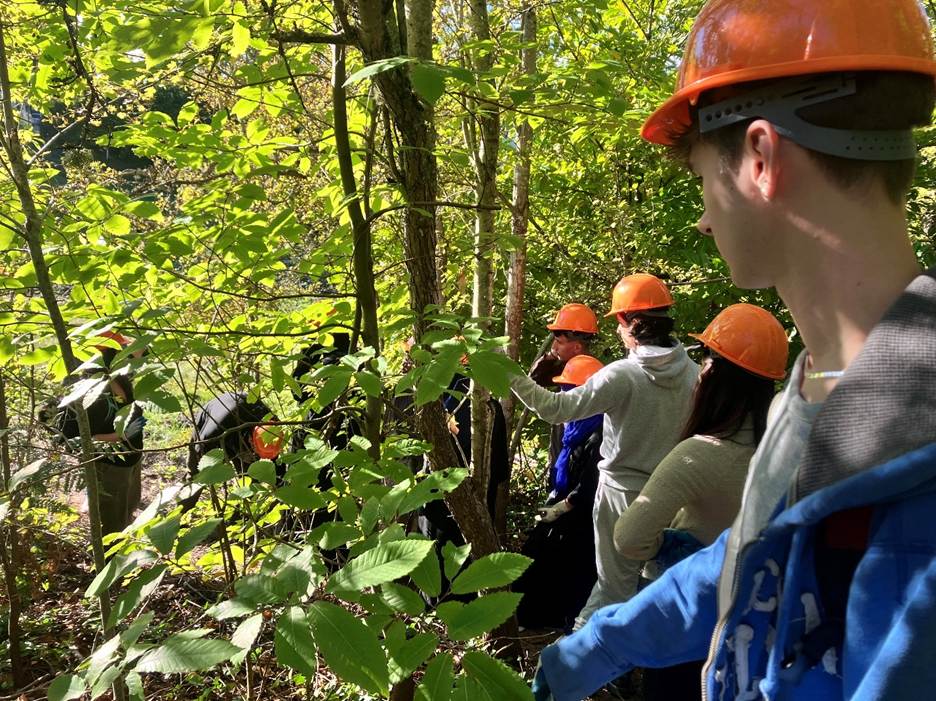
Partner in Employment Summer Youth Cohort tours their site and plans stewardship activities in Kubota Garden Natural Area as part of their Environmental Restoration program. Partner in Employment connects immigrants, refugees and their families in South King County to professional development opportunities and high paying jobs. Learn more
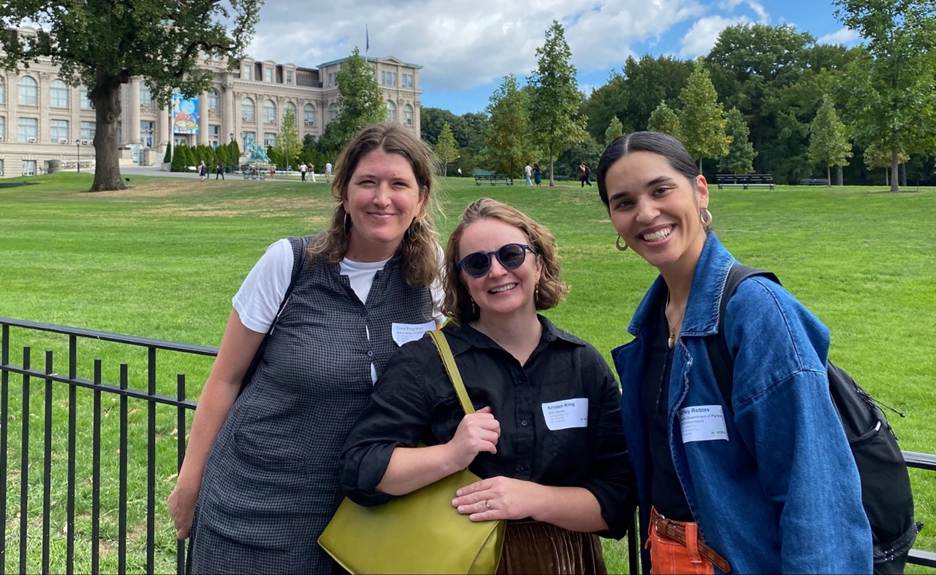
In September, NYC Parks celebrated the 40th anniversary of the natural area conservation division of their department. Interim Plant Ecologist Ashley Robles (right) spoke on behalf of Green Seattle Partnership about the deep connections and valuable relationships that we build with community volunteers and local partner organizations, reflecting on the pathway into our communities that partnership offers.
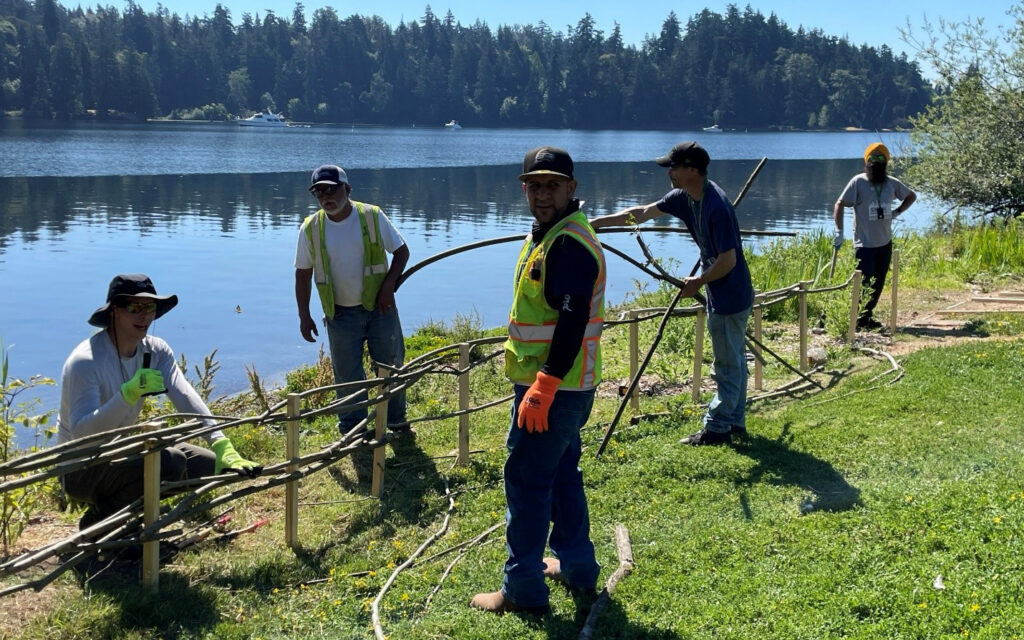
Along with protecting trees from beavers, the NAC also protects new plantings from people and dogs with fencing. The picture above shows NAC members Teo Martinez, Herbert Arias, Todd Gauthun, Daljit Singh and Senior Gardener Matthew Hilliard getting creative with fencing, using willow and dogwood branches harvested from local natural areas to construct a more natural fence along Lake Washington shoreline. This project was a lot of fun for the crew to work.
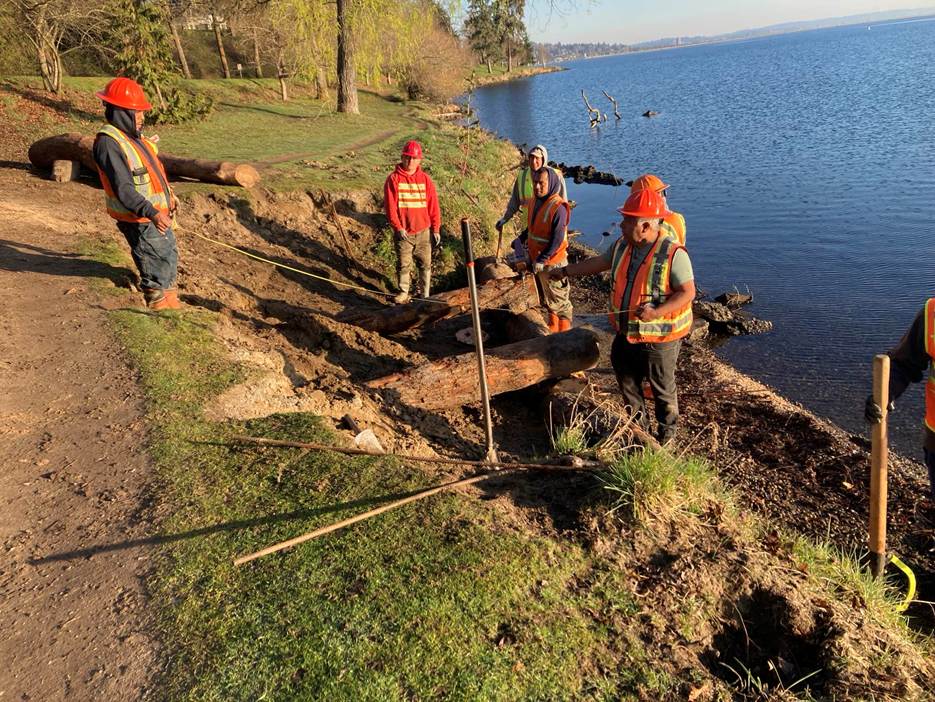
Seattle Parks and Recreation Trails Program worked with Green Seattle Partnership staff and Zaldivar’s Forestry to repair an eroding stretch of shoreline along Lake Washington Blvd. A great example of stewardship that benefits both wildlife, lake ecology and people!
During this year’s YMCA Earth Service Corps Youth Summit, Seattle Parks and Recreation Plant Ecologists Jacob de Guzman and Michael Helms hosted a table discussion title Environmental Justice: Local Ways to Make a Global Impact, highlighting stewardship & professional development opportunities for youth at Green Seattle Partnership.
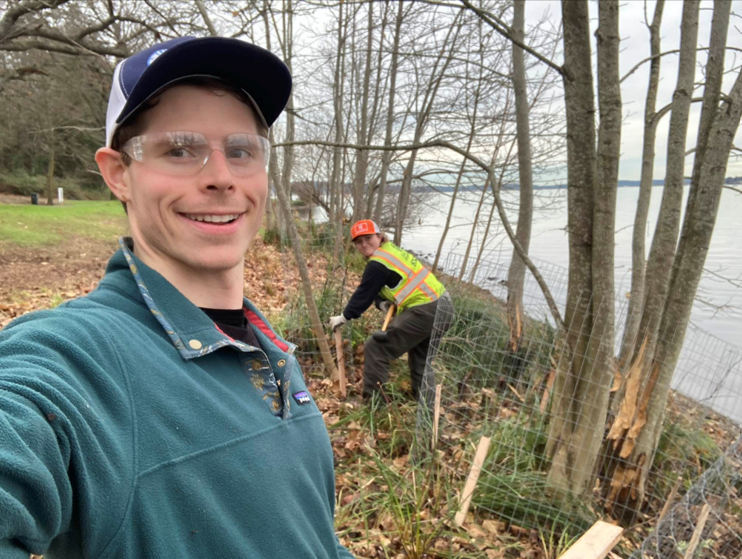
Natural Areas Crew Senior Gardener Matthew Hilliard and Gardener Jay Nelson installed protective metal caging around trees along Lake Washington shoreline. Beaver populations have been increasing in Seattle, providing immense benefits to the ecosystems in town. With more beavers though, comes more need for beaver food (i.e. trees). The team worked with Seattle Parks and Recreation IPM and Wildlife Manager Bridget Kelsh and the Urban Forestry team, to develop updated strategies for caging and to install fencing to ensure a healthy balance between the need to protect our urban forest and provide beavers with sustenance.
In February, GSP and Seattle Parks and Recreation’s Urban Forestry staff teamed up to support Black Forest’s tree planting event in Seattle. Together, they created “a living monument and archive for black lives”. Read more
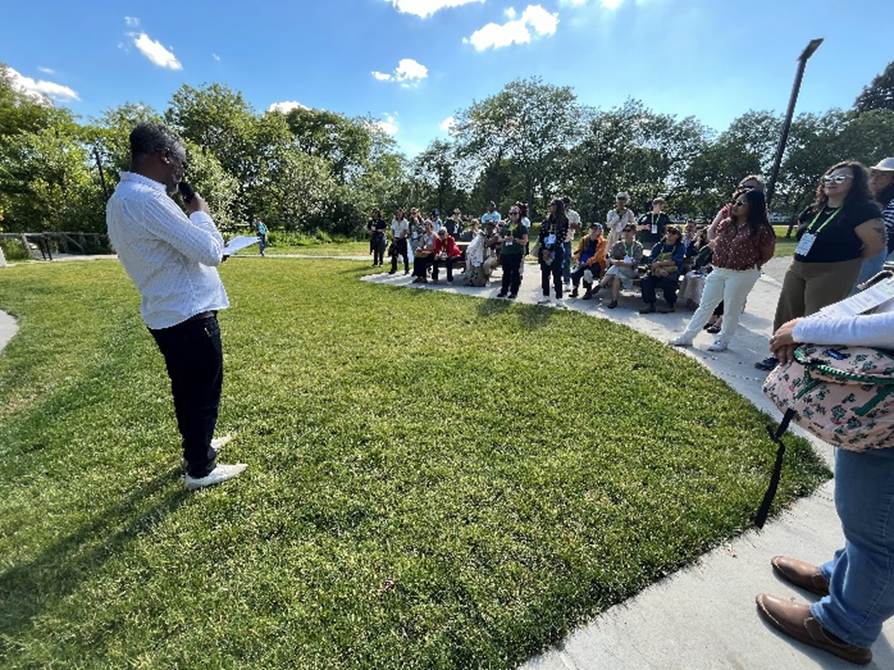
Armaye Eshete from GSP partner Serve Ethiopians Washington joined staff from Tilth Alliance, Partner in Employment, EarthCorps, Seattle Parks and Recreation, and Kubota Garden Foundation to share about our collective efforts at Be’er Sheva, Rainier Beach Urban Farm and Wetland, and Kubota Garden Natural Area to engage community members in natural area care. Attendees were participating with the Greater Greener Conference. Read more at Sharing Green Seattle with Summer Visitors from Near and Far.
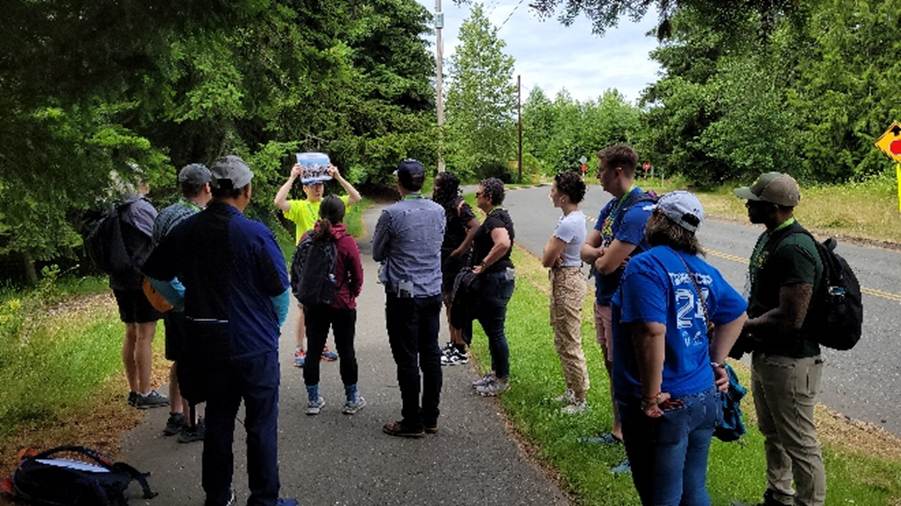
Seattle Parks and Recreation’s Eric Sterner led Greater and Greener Conference attendees on a walking tour of Discovery Park, one of Seattle’s largest parks (534 acres) and one of its most ecologically diverse, with bluffs overlooking Puget Sound, tidal beaches, groves of madrona trees, and meadows.

Cub Scouts returned for a second year at Puget Park with Forest Steward Christine Clark. They went on a ‘herb Robert’ hunt, and learned about what plants are help support habitat and which do not. Great, energetic group who says will be back again next year!
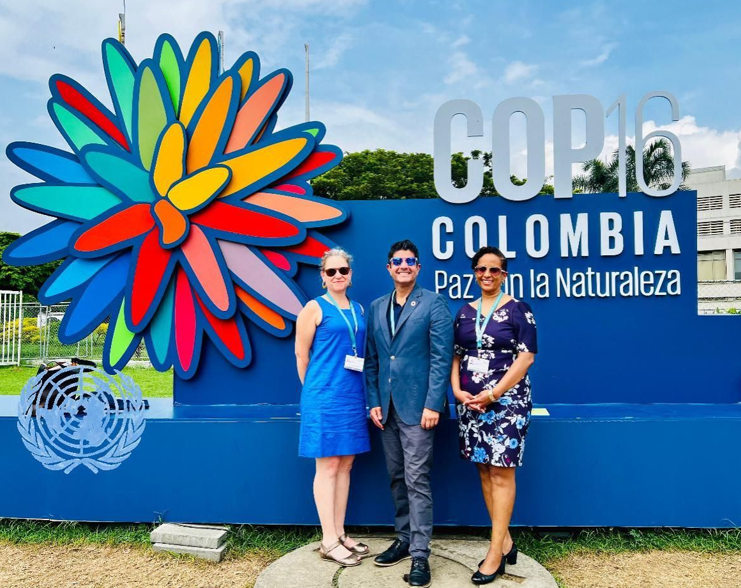
Deputy Mayor Adiam Emery, Seattle Parks and Recreation Superintendent AP Diaz, and Natural Resources Manager Stephanie Shelton attended the Global Convention on Biological Diversity in Colombia. They represented Green Seattle Partnership during several presentations. Read more here: Seattle Representing! Global to Local Urban Ecological Restoration at COP16 – Green Seattle Partnership.
Youth employees from the Seattle chapter of the Student Conservation Association stand proud rebuilding dozens of box steps in Colman Park – no small task! The crew also worked on trail-clearing maintenance and weed management.
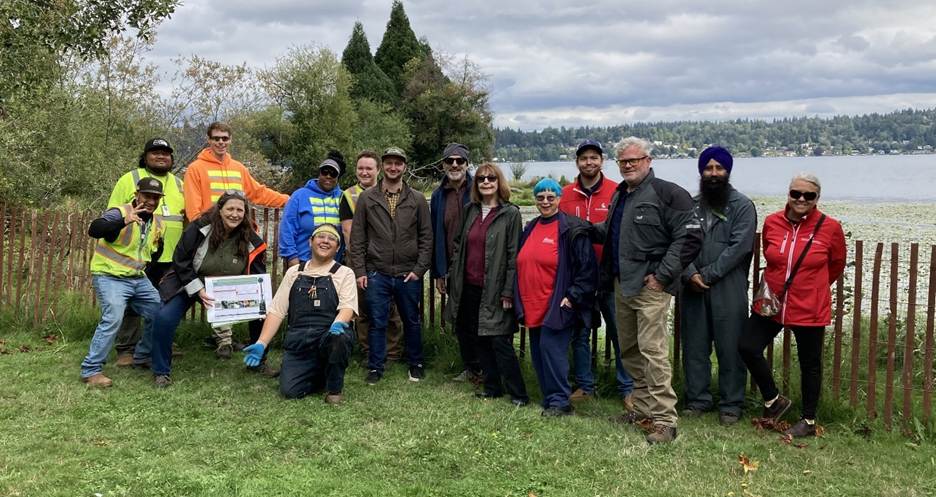
Seattle Parks and Recreation’s Natural Area Crew and Wildlife Manager Bridget Kelsh joined community members to tour the natural area around Lakewood Marina where they have collaborated on improving wildlife habitat over the last couple years.
Seattle Parks and Recreation’s Natural Area Crew increased support for beaver management efforts in Seattle Parks this year, working hard to implement coexistence strategies that improve riparian habitat complexity and health while addressing infrastructure conflicts.
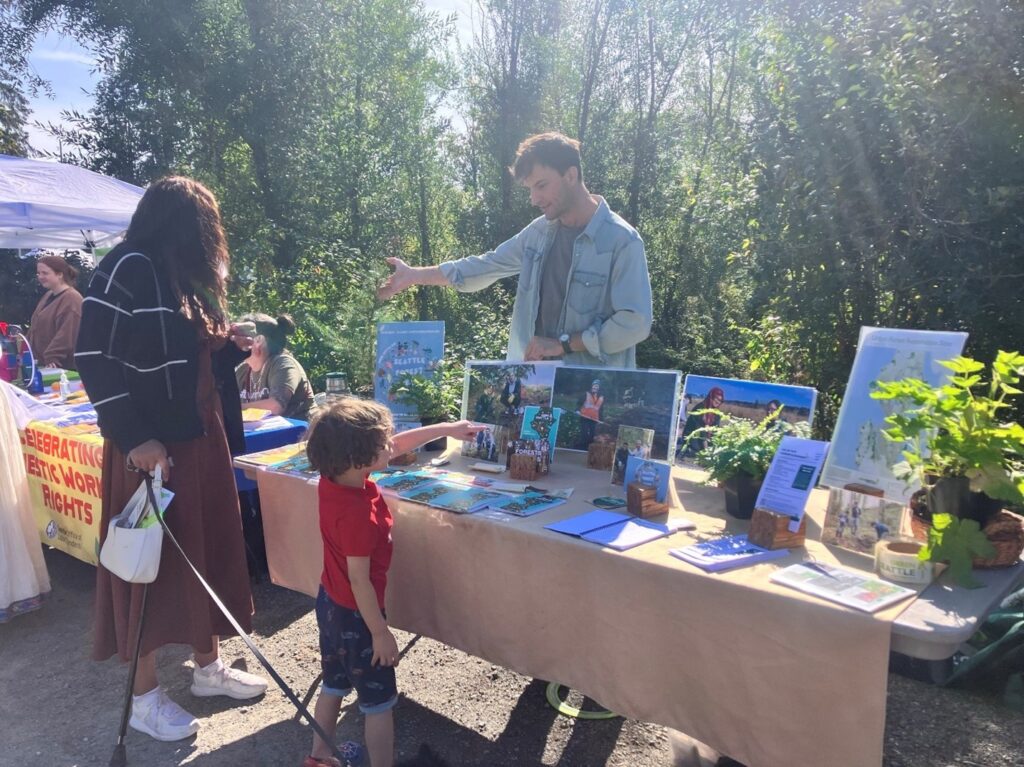
Seattle Parks and Recreation’s Plant Ecologist Michael Helms joined Tilth Alliance’s annual Rainer Beach Farm Fest for sunshine and smiles, sharing Green Seattle Partnership alongside other community organizations and educators.
October was a spooky and fun time partnership-wide! Seattle Parks and Recreation staff joined the ‘Great Pumpkin Carving Competition’ and although the effort was mighty, we did not win…this year. Featured right: staff from GSP partner organizations met to carve pumpkins & discuss expanding stewardship opportunities for Seattle’s underrepresented cultural communities.
Shameka Gagnier of Futures Rising: Restoration & Co-Creation supported a panel discussion at UW’s Hip Hop Climate Conference 2024 amongst other Climate Leaders & Educators
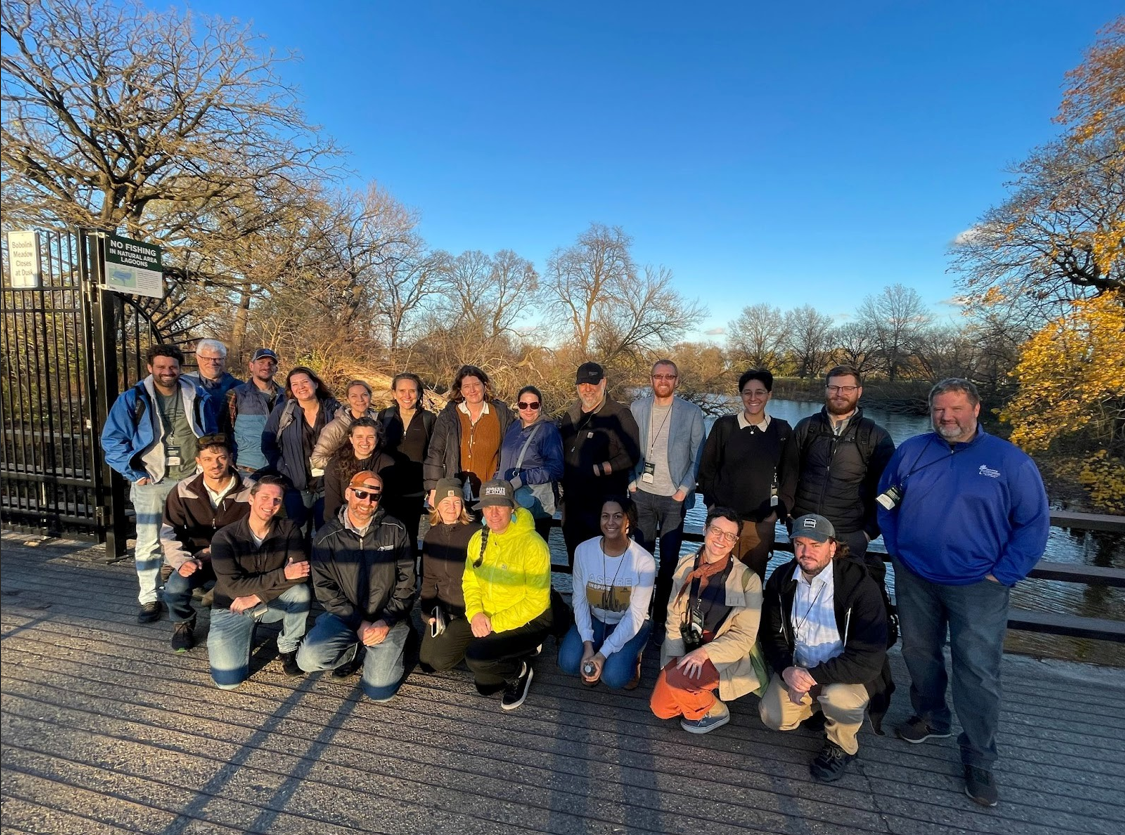
Seattle Parks and Recreation’s Senior Ecologist Danielle Devier presented in Chicago on Cultivating Community Connections: A Holistic Approach to Urban Forestry Engagement at the Urban Community Forest Society (UCFS) meeting as part of the Partners in Urban and Community Forestry conference.
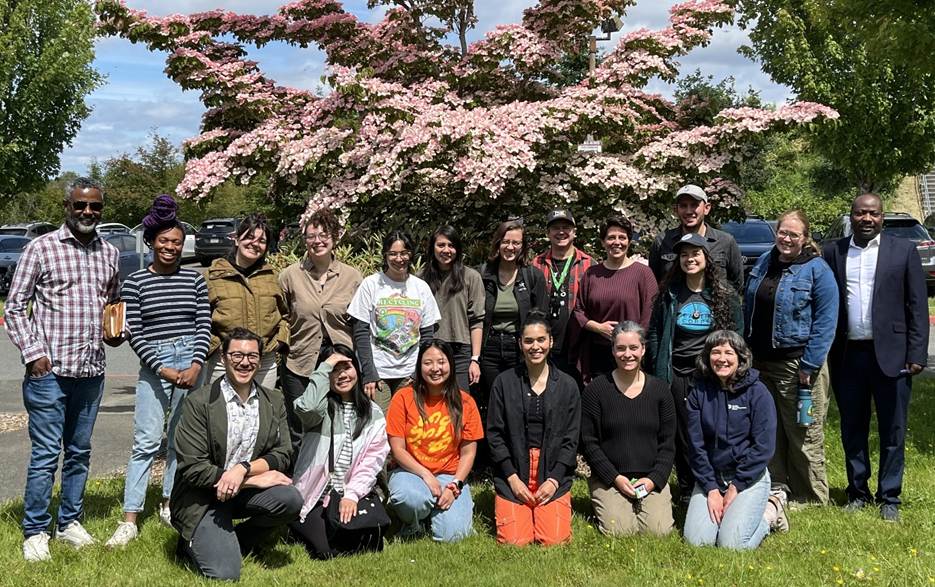
Green Seattle Partnership’s Public Engagement Committee came together 3 times in 202r4 to guide GSP programming and build a space for partner collaboration.
A heartfelt THANK YOU to each and every person that helped make 2024 with Green Seattle Partnership such a unique and special collaborative public program!
Zaldivars Forestry:
Zaldivar’s completed a massive planting project along Lake Washington Blvd in 2024. This popular shoreline has dealt with erosion, harmful weed species and a lack of native plants that could provide much needed habitat and help hold the shoreline together. All of this was further complicated by the heavy public usage of the shoreline, including SeaFair, which flooded the work area with thousands more people over a few summer days. Despite that, the work held up and Zaldivar’s gave this site exactly what it needed, completely transforming it to the benefit of human, animal and plant communities alike.
Applied Ecology:
In 2024, Applied Ecology took on the daunting task of our Citywide Noxious Weed Control contract, a joint effort between GSP and King County. This project had them traveling all over the city to deal with some of our most hazardous weeds, such as poison hemlock. They would respond quickly to new populations as they would get flagged, either from GSP, the county, Parks Districts or members of the public. This was a complicated but vital part of our program that they managed exceptionally well.
EarthCorps:
In 2024, EarthCorps began a shoreline restoration project in Magnuson Park. This is a site that’s extremely popular in the summer months for swimming and other forms of recreation, despite being dominated by blackberry patches in large sections. EarthCorps’ hard work to remove the blackberry and other weeds, and their ongoing efforts to add native plants, has created even more space for public enjoyment, and space that is healthier, more beautiful and more sustainable.
Dirt Corps:
In 2024, Dirt Corps accomplished an extensive weeding and planting project in the West Duwamish Greenbelt, north of Westcrest Park. This greenbelt is the largest contiguous forest in Seattle, making it an exciting but difficult place to work. Much of the project was in deep and hard to access parts of the forest, meaning that crews had to hike in all of their tools and plants, across steep slopes, through weedy thickets and rough, muddy terrain. Dirt Corps braved one of the wildest parts of our city to create a healthier habitat that benefits our entire ecosystem, even if it isn’t seen by many human eyes.
Habitat Restoration Specialists:
Habitat Restoration Specialists was tasked with a planting and weeding project along the Green Lake shoreline in 2024. Green Lake is one of the most popular parks in the city, with an immense number of walkers, runners, cyclists and other users on a daily basis. HRS had to work methodically to interact with park users as safely as possible, especially when it came to watering plants and dragging hoses. They were able to increase native vegetation and improve the shoreline habitat without causing problems for the hundreds of passersby they worked around every day.
Signature Landscapes:
In 2024, Signature Landscapes began a large restoration project along the Jackson Park Trail, which winds around the Jackson Park Golf Course in Northeast Seattle. This is a multi-faceted project including weeding, watering and planting, further complicated by heavily compacted soils, fire and storm damage, and even fire ants. Beyond that, Signature was also tasked to improve sightlines with CPTED pruning and to improve drainage by removing excess debris from Littles Creek, which runs through the site. This is another very public site, with Jackson Park Trail hosting many daily users. The improved habitat around the trail and the creek will be a great benefit to the people and wildlife that use it.
